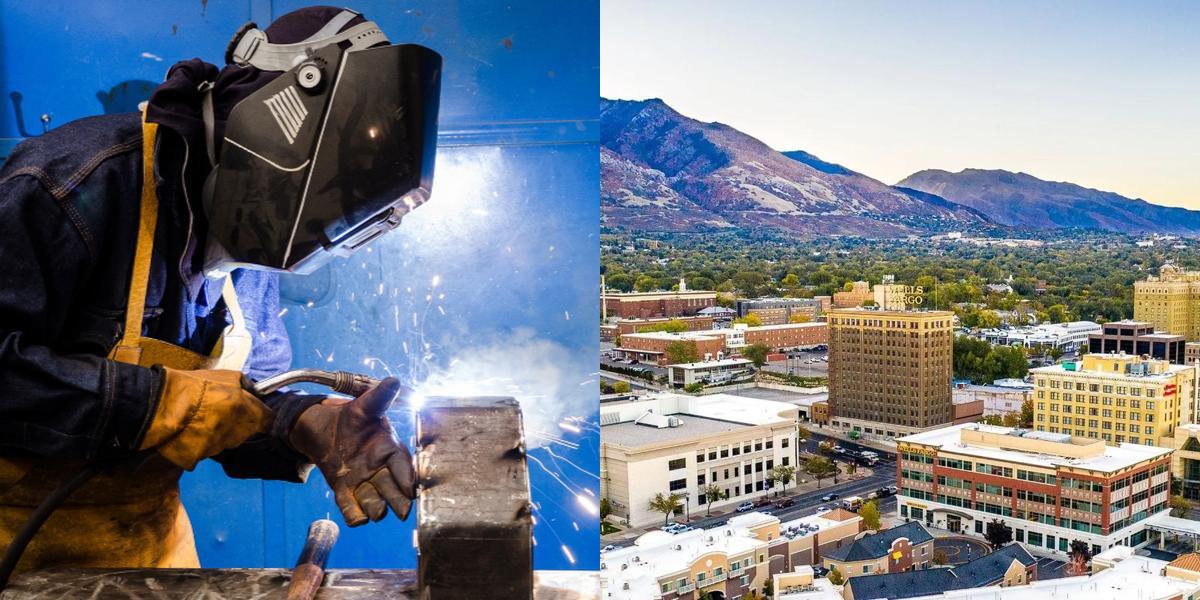How to Become a Welder in Utah

What is a Welder?
A welder is a skilled tradesperson who specializes in fusing metal parts together using heat and pressure. They work with various types of metals, such as steel and aluminum, to create and repair structures, equipment, and machinery. Welders use different welding techniques, such as arc welding, gas welding, and resistance welding, to join metal components and ensure the integrity and strength of the finished product.
The responsibilities of a welder include:
- Reading and interpreting blueprints, sketches, and specifications to determine the welding requirements
- Selecting and preparing the appropriate welding equipment and materials
- Cleaning and inspecting metal surfaces to ensure proper welding conditions
- Setting up and operating welding machines
- Welding metal parts together according to the specified guidelines and standards
- Conducting quality control checks to ensure the welds meet the required standards
- Repairing or modifying existing metal structures as needed
- Following safety procedures and wearing protective gear to prevent accidents and injuries
How do I get a job as a Welder?
Once you have obtained your welder certification, the next step is to secure a job as a welder. Here are some tips to help you in your job search:
-
Network: Networking is a crucial aspect of finding job opportunities in any field, including welding. Connect with individuals who work in the welding industry, join professional organizations, and attend industry events. These connections can provide valuable insights, job leads, and recommendations.
-
Create a resume: Craft a professional resume that highlights your skills, experience, and certifications. Tailor your resume to the specific welding job you are applying for, emphasizing relevant qualifications and achievements. Don't forget to include your welder certification and any additional certifications you may have obtained.
-
Apply to job postings: Look for job postings in your area or desired location. Online job boards, company websites, and industry-specific websites are excellent resources for finding welding job opportunities. Make sure to read the job descriptions carefully and submit your application materials accordingly.
-
Build a portfolio: Creating a portfolio of your work can showcase your welding skills and help you stand out from other candidates. Include pictures or videos of your completed projects, highlighting your expertise in different welding techniques. A portfolio can be particularly beneficial if you are applying for freelance or contract work.
-
Consider apprenticeships: Apprenticeships provide valuable on-the-job training and can be a great way to gain experience and establish connections in the welding industry. Many companies and trade unions offer apprenticeship programs, so be sure to explore these opportunities.
-
Prepare for interviews: Prior to attending interviews, research the company and familiarize yourself with their operations, projects, and values. Practice common interview questions and prepare examples that demonstrate your welding abilities and problem-solving skills. Dress professionally and bring copies of your resume and certifications.
-
Continuing education: The field of welding is constantly evolving, with new technologies and techniques emerging. To stay competitive and increase your job prospects, consider pursuing additional certifications or continuing education courses. This shows employers that you are committed to professional growth and staying ahead in your field.
Remember, finding a job as a welder may take time and effort. Stay persistent, keep refining your skills, and be open to different opportunities. With the right combination of qualifications and dedication, you can find a rewarding career as a welder.
Career Paths and Opportunities after Becoming a Welder
Once you have become a certified welder, there are various career paths and opportunities available to you. Here are a few examples:
-
Construction: Welders are in high demand in the construction industry. They play a crucial role in building and repairing structures such as bridges, buildings, and pipelines. Construction companies often hire welders for both short-term and long-term projects.
-
Manufacturing: Welders are essential in the manufacturing sector, where they are responsible for fabricating and assembling metal parts. This can include anything from automotive manufacturing to aerospace industries. Manufacturing companies often require welders with specialized skills and knowledge in specific welding techniques.
-
Engineering: Welders with advanced skills and experience may find opportunities in engineering firms. They may be involved in designing and creating prototypes, conducting welding inspections, or providing technical expertise in welding processes.
-
Shipbuilding and offshore industries: Welders are in demand in shipbuilding and offshore industries, where they are responsible for constructing and repairing ships and offshore structures. This sector often requires welders with specialized certifications, such as underwater welding or welding in confined spaces.
-
Pipeline welding: Pipeline welding involves joining sections of pipes together to create a network for transporting oil, gas, or water. This field requires specialized knowledge and certifications to ensure the integrity and safety of the pipelines.
-
Freelancing: Some welders choose to work as freelancers, taking on projects independently or on a contract basis. Freelancing offers flexibility and allows welders to work on a variety of projects and gain experience in different industries.
-
Teaching and training: Experienced welders may choose to share their knowledge and skills by becoming welding instructors or trainers. They can work in vocational schools, community colleges, or training centers, helping to shape the next generation of welders.
These are just a few examples of the career paths and opportunities available to certified welders. The field of welding offers a wide range of options, depending on your interests, skills, and certifications. As you gain more experience and expertise, you may also have the opportunity to advance into supervisory or managerial roles.
How much does a Welder make?
The average salary for a welder can vary depending on factors such as experience, location, and industry. According to the U.S. Bureau of Labor Statistics (BLS), the median annual wage for welders, cutters, solderers, and brazers was $43,410 as of May 2020. The lowest 10 percent earned less than $30,860, while the highest 10 percent earned more than $64,240.
Starting salaries for welders can vary greatly. Entry-level welders with little to no experience may start at or near the lower end of the salary range. However, as they gain experience and develop their skills, their earning potential increases.
Final Thoughts
Becoming a certified welder opens up numerous career opportunities in various industries. By completing a welding program, gaining practical experience, and obtaining your welder certification, you can establish yourself as a skilled professional in the field of welding. Remember to stay updated on industry trends, network with professionals, and continuously enhance your skills through additional certifications and training. Good luck on your journey to becoming a welder!
If this article isn't quite hitting the mark for you, why not give these other articles a try:

Winlynd Caballero is a member of Dreambound's Sales team. She helps in handling the company's finullcial transactions, generating reports, and school sales. Beyond her responsibilities in the realm of numbers and business, Winlynd finds herself deeply immersed in a world of art and music.



